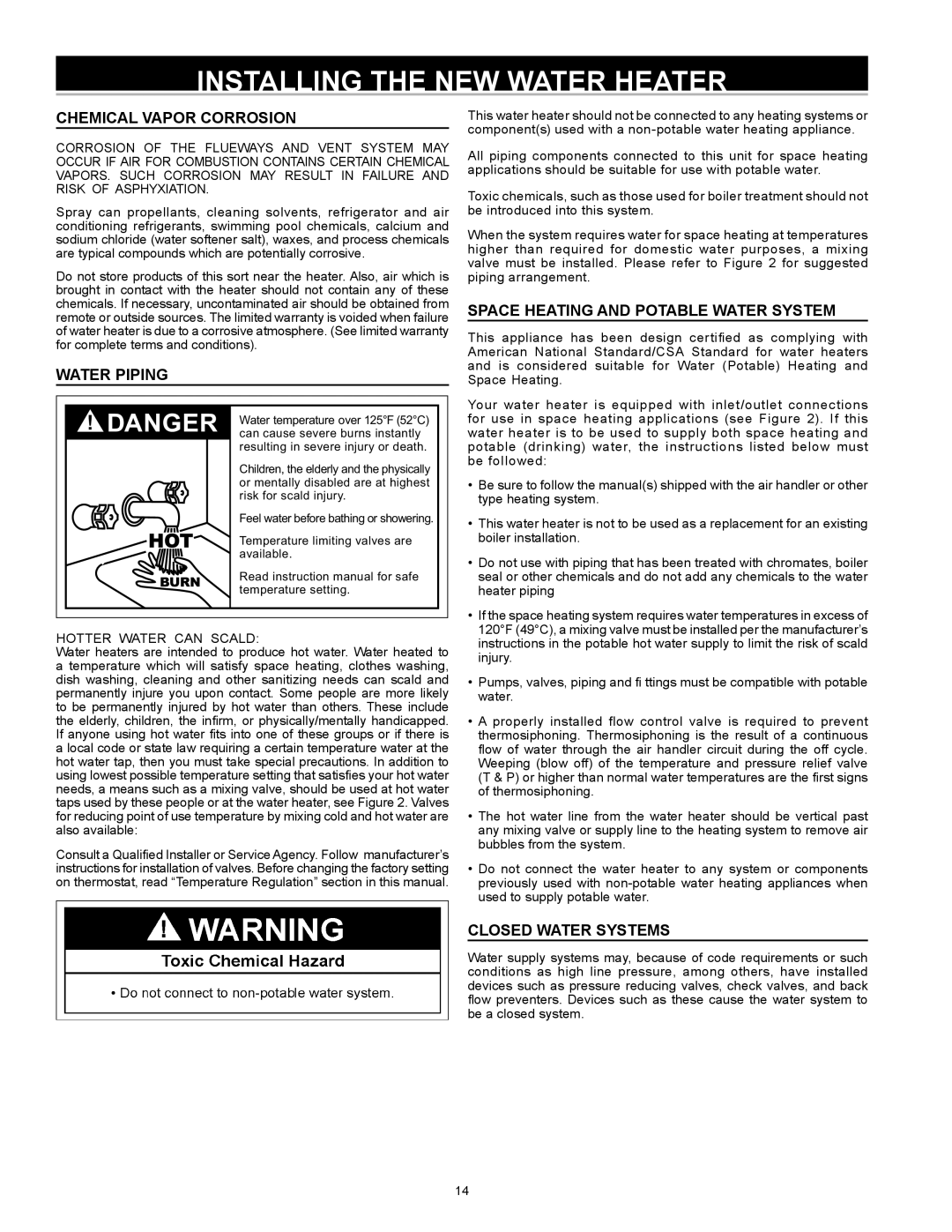
INSTALLING THE NEW WATER HEATER
CHEMICAL VAPOR CORROSION
CORROSION OF THE FLUEWAYS AND VENT SYSTEM MAY OCCUR IF AIR FOR COMBUSTION CONTAINS CERTAIN CHEMICAL VAPORS. SUCH CORROSION MAY RESULT IN FAILURE AND RISK OF ASPHYXIATION.
Spray can propellants, cleaning solvents, refrigerator and air conditioning refrigerants, swimming pool chemicals, calcium and sodium chloride (water softener salt), waxes, and process chemicals are typical compounds which are potentially corrosive.
Do not store products of this sort near the heater. Also, air which is brought in contact with the heater should not contain any of these chemicals. If necessary, uncontaminated air should be obtained from remote or outside sources. The limited warranty is voided when failure of water heater is due to a corrosive atmosphere. (See limited warranty for complete terms and conditions).
Water Piping
This water heater should not be connected to any heating systems or
component(s) used with a
All piping components connected to this unit for space heating applications should be suitable for use with potable water.
Toxic chemicals, such as those used for boiler treatment should not be introduced into this system.
When the system requires water for space heating at temperatures higher than required for domestic water purposes, a mixing valve must be installed. Please refer to Figure 2 for suggested piping arrangement.
SPACE HEATING AND POTABLE WATER SYSTEM
This appliance has been design certified as complying with American National Standard/CSA Standard for water heaters and is considered suitable for Water (Potable) Heating and Space Heating.
![]() DANGER
DANGER
Water temperature over 125°F (52°C) can cause severe burns instantly resulting in severe injury or death.
Children, the elderly and the physically or mentally disabled are at highest risk for scald injury.
Feel water before bathing or showering.
Temperature limiting valves are available.
Read instruction manual for safe temperature setting.
Your water heater is equipped with inlet/outlet connections for use in space heating applications (see Figure 2). If this water heater is to be used to supply both space heating and potable (drinking) water, the instructions listed below must be followed:
• Be sure to follow the manual(s) shipped with the air handler or other |
type heating system. |
• This water heater is not to be used as a replacement for an existing |
boiler installation. |
• Do not use with piping that has been treated with chromates, boiler |
seal or other chemicals and do not add any chemicals to the water |
heater piping |
• If the space heating system requires water temperatures in excess of |
120°F (49°C), a mixing valve must be installed per the manufacturer’s |
HOTTER WATER CAN SCALD:
Water heaters are intended to produce hot water. Water heated to a temperature which will satisfy space heating, clothes washing, dish washing, cleaning and other sanitizing needs can scald and permanently injure you upon contact. Some people are more likely to be permanently injured by hot water than others. These include the elderly, children, the infirm, or physically/mentally handicapped. If anyone using hot water fits into one of these groups or if there is a local code or state law requiring a certain temperature water at the hot water tap, then you must take special precautions. In addition to using lowest possible temperature setting that satisfies your hot water needs, a means such as a mixing valve, should be used at hot water taps used by these people or at the water heater, see Figure 2. Valves for reducing point of use temperature by mixing cold and hot water are also available:
Consult a Qualified Installer or Service Agency. Follow manufacturer’s instructions for installation of valves. Before changing the factory setting on thermostat, read “Temperature Regulation” section in this manual.
instructions in the potable hot water supply to limit the risk of scald |
injury. |
• Pumps, valves, piping and fi ttings must be compatible with potable |
water. |
• A properly installed flow control valve is required to prevent |
thermosiphoning. Thermosiphoning is the result of a continuous |
flow of water through the air handler circuit during the off cycle. |
Weeping (blow off) of the temperature and pressure relief valve |
(T & P) or higher than normal water temperatures are the first signs |
of thermosiphoning. |
• The hot water line from the water heater should be vertical past |
any mixing valve or supply line to the heating system to remove air |
bubbles from the system. |
• Do not connect the water heater to any system or components |
previously used with |
used to supply potable water. |
Closed Water Systems
Water supply systems may, because of code requirements or such conditions as high line pressure, among others, have installed devices such as pressure reducing valves, check valves, and back flow preventers. Devices such as these cause the water system to be a closed system.
14
